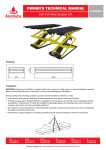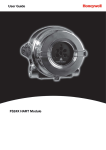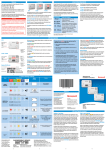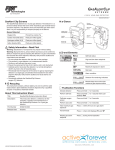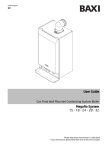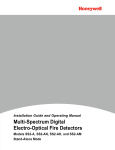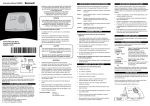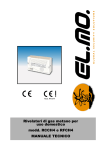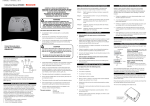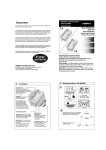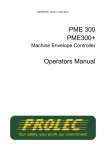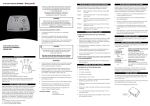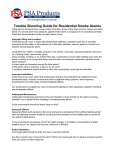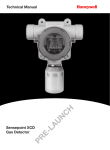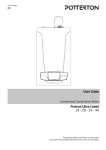Download HF500 Manual - Accutherm International
Transcript
Operating and Installation Instructions About Flammable Gas Thank you for purchasing this gas detector, which is designed for use in domestic premises (including static caravan holiday homes) to detect leaks of flammable gas. The detector must be connected to mains power. Flammable gas is dangerous if the concentration builds up enough to become explosive. This level is called the lower explosive limit (LEL). The HF500 detector will alarm if the gas concentration reaches 10 % of the lower explosive limit (10 %LEL). This manual contains important safety information about the installation and operation of the detector. Read the manual carefully and keep it in a safe place for future reference. Note: Natural Gas and LPG have additives which gives them a distinctive smell. Most people are able to smell Natural Gas or LPG at a lower concentration than the detector alarm setting. This does not mean that the detector is faulty. Warnings • This gas detector must be installed by a competent person qualified to carry out electrical work according to current national wiring regulations. Additionally, any changes to the gas installation,e.g., fitting of an automatic gas shut-off valve, must be carried out by a person qualified to the national regulations for gas installations. Power Alarm Fault • The gas installation and shut-off device (where used) must comply with the appropriate national regulations. Description The detector has two relays, alarm and fault. The alarm relay can be used to activate an external device such as a gas shut down valve, or an automatic signal such as a call to the emergency services. The fault relay can be used to activate a signal to an external device such as a supervisory panel. Contact Us Methane Gas Detector HF500NG Power Please Note: While every effort has been made to ensure accuracy in this publication, no responsibility can be accepted for errors or omissions. Data may change, as well as legislation, and you are strongly advised to obtain copies of the most recently issued regulations, standards, and guidelines. This publication is not intended to form the basis of a contract. If the alarm stops, check the following: - Do not tamper with the detector – there is a risk of electric shock or damage to the detector. 1. Has the source of the gas leak been identified (for example a gas tap switched on with the burner unlit)? 2. Has the gas leak been stopped? If required, clean the surface of the detector with a lightly damped cloth. Do not use detergent as this may damage the internal sensor. If the answer to either of these questions is no, then notify the gas supplier or the gas emergency service so that the installation may be tested and made safe, and any necessary repair carried out. Summary Table Condition Power Light (Green) Alarm Light (Red) Fault Light (Yellow) Audible Alarm Power on, no gas OFF ALARM, gas detected Power Fault Sensor Fault Normal operation ON Gas detected Intermittent single chirp There is a fault with the electrical installation 2 long chirps per minute Software Fault Meaning Continuous chirps The detector must be replaced If your Detector is in alarm UK GAS EMERGENCY SERVICE TELEPHONE NUMBER 0800 111 999 Tell the operator that your flammable gas detector is in alarm and you suspect that there is a gas leak. Extinguish all naked flames, including all smoking material Turn off all gas appliances Do not switch on or off any electrical equipment, including the gas detector Turn off the gas supply Open doors and windows to increase ventilation Do not use a telephone where gas may be present If the alarm continues, and the cause of the leak cannot be found, vacate the premises and IMMEDIATELY NOTIFY the gas supplier or the gas emergency service. Recommended replacement date RAL 90 10 P ure White 12797 HF500NG MAN0899_Issue 1_06/12_EMEAI © 2012 Honeywell Analytics TEST / HUSH Replace unit by 01.2016 Precautions during use Detector Operation - continued If the detector is in FAULT (YELLOW light) it must not be used any more, and should be replaced. (The exception is if the detector signals a Power Fault indicated by an intermittent single chirp. In this case there may be a fault with the power supply and the electrical installation should be checked). Test/ Hush button Fault Acts for and on behalf of Life Safety Distribution AG, Javastrasse 2, 8604 Hegnau, Switzerland by its Authorised Representative Honeywell Inc. If the detector is in ALARM and the gas clears, the detector will return to normal operation. Audible alarm Indicator lights Alarm UK customer service centre NG - Natural Gas LPG - Liquified Petroleum Gas Detector Operation • • • • • • Gas entry point Caution: Read and follow manufacturers instructions carefully before operating or servicing Honeywell Analytics Ltd. 4 Stinsford Road Nuffield Industrial Estate Poole, Dorset BH17 0RZ Tel: +44 (0)1202 645577 Fax: +44 (0)1202 665331 [email protected] LPG (Liquefied Petroleum Gas) is a mixture of primarily propane, primarily butane or both. The gas is heavier than air, so any leak will result in a build up of gas at a low level. (This is why the installer will place the detector near the floor) If your detector is in ALARM, keep calm, and carry out the following actions, not necessarily in the order given: www.honeywellanalytics.com www.hf500gasalarm.com www.honeywell.com HF500NG / HF500LPG Residential Flammable Gas Detector • • If the detector is in ALARM, the audible alarm can be silenced for 5 minutes by pressing the TEST/HUSH button (the RED light will continue to flash). If gas is still present after 5 minutes, the audible alarm will sound again. The GREEN light indicates that the power to the detector is ON. The RED light indicates that GAS has been detected. The YELLOW light indicates that there is a FAULT with the detector. TEST / HUSH Natural Gas is primarily Methane Natural Gas is lighter than air, so any leak will result in a build up of gas at a high level within a room or enclosed area. (This is why the installer will place the detector near the ceiling) If GAS is detected the RED ALARM light will flash and the audible alarm will sound. The detector has three status indicator lights, an audible alarm and a test/hush button. Replace unit by 01.2016 • • Some materials such as cleaning fluids, polishes, paints, cooking operations etc. may generate fumes which could cause false alarms from the detector or affect its long term reliability. Avoid using these substances close to the detector. 1 2 Disclaimer Specification This flammable gas detector is designed to alert you to a potentially dangerous build up of flammable gas. It is not designed to remedy a flammable gas problem nor to locate a specific leak of flammable gas. Honeywell shall not be liable to pay for any investigation or service call carried out or arranged in response to an alarm. Warranty Warning Honeywell warrants your new gas detector for two years from the date of purchase by the end user or until the expiry date on the front of the unit, whichever occurs first, according to the specifications as set out in this instruction manual. Silicones can permanently damage the detector. Avoid using silicone sealant or any household or cosmetic product containing silicone in the vicinity of the detector. We will, at our discretion, repair or replace, with same or similar product, any part of the gas detector which is found to be defective in either materials or workmanship within the warranty period. Monthly Detector test We shall be under no obligation to repair or replace units which are found to be defective in any way due to unreasonable use or neglect, improper storage, used or maintained not in accordance with the user manual or if the product has been tampered with or found to have been dismantled. The detector should be tested once per month. To test the detector, press and hold the “TEST/HUSH” button on the front cover for 1 second. The RED light will flash 4 times, and then the YELLOW light will flash 4 times, accompanied by the audible alarm sounding 8 times. Caution: Testing the detector with an uncontrolled source of gas (for example a cigarette lighter) may give a misleading result and could damage the detector. Conformance to European standards The HF500NG Natural Gas detector and the HF500LPG Liquefied Petroleum Gas detector conform to EN50194-1, which is the European Standard for electrical apparatus for the detection of combustible gases in domestic premises. A full EC declaration of conformity is available at our website. Navigate to www.honeywellanalytics.com and select Resources, then EC Declarations. End of Life The detector should operate for 5 years under normal use. The recommended replacement date is shown on the front of the detector. This warranty is instead of and excludes all warranties implied by law, and to the extent permitted by law, our liability under the warranty is capped at the price of the product. In no event are we liable for (a) any direct, indirect, incidental, consequential loss; (b) any loss arising from business interruption; (c) loss of profits; (d) loss of revenue; (e) loss of use of any property or capital; (f) loss of anticipated savings or loss of data. Troubleshooting and getting assistance After you have carefully read all instructions and your alarm still fails to work, contact the nearest Customer Service listed in the “Contact Us” section, which might be able to resolve your problem quickly. Alternatively contact your local supplier. If the product needs to be returned for repair or replacement, put it in a padded box with a letter describing the fault and postage paid. For battery powered devices, ensure that the alarm has been switched-off. Calibration Gas Methane (Natural Gas Version), Propane (LPG Version) Calibration Level 10% LEL (Lower Explosive Limit) Sensor Technology Catalytic combustion Accuracy Tolerance ± 2.5% LEL Dimensions 150mm x 104 mm x 40 mm Weight < 400 g Installation Surface mounting Power 110 - 230 Vac 50/60 Hz Power Consumption < 6.5 W Alarm Relay 5 A 250 Vac SPDT (single pole changeover) Fault Relay 0.25A 250VAC SPST NO (single pole) Temperature -10 °C to +55 °C Humidity 0-95% RH (non-condensing) Test Facility Yes Self Check Function Yes A proof of purchase must be provided to claim repair under warranty. When the unit has come to the end of its life, dispose of it in accordance with local regulations. It is classified as electronic waste and should be disposed of separately from household waste. Gas appliances should be checked for safety annually by a Gas Safe registered engineer. To find a registered engineer in your area call Gas Safe Register on 0800 408 5500 or look on the website: www.gassaferegister.co.uk. 3 4 5 6 The detector should be installed in the room where a gas escape is most likely to occur. For most installations the most likely source of a gas leak will be the cooker in the kitchen • This gas detector must be installed by a competent person qualified to carry out electrical work according to current national wiring regulations. Additionally, any changes to the gas installation, e.g., fitting of an automatic gas shut-off valve, must be carried out by a person qualified to the national regulations for gas installations. • The gas installation and shut-off device (where used) must comply with the appropriate national regulations. LPG • • The installer should refer to the current edition of the European Standard EN 50244 “Electrical apparatus for the detection of combustible gases in domestic premises – Guide on the selection, installation, use and maintenance.” Caution: The installation must include some form of isolation switch. Note: It is recommended that flexible cable is used, e.g. 1.0 mm2 core. For a surface mount installation, the use of mini-trunking is recommended. Natural Gas • Natural Gas is lighter than air, so a leak of gas will build up at a high level. The detector should be placed above the level of a possible gas escape and near the ceiling • The detector should be placed above the highest window or door opening, usually not more than 30 cm from the ceiling • The detector should be located between 1 m and 5 m from the gas appliance. Installation - continued The detector should be wired to the mains power supply using a flexible cable appropriately rated via a fused connection outlet and fitted with a 3A fuse to BS1363-4 and BS1362 respectively, or according to local regulations. The power supply cabling and connections for the relays (if used) can be routed through the back of the Mounting DRG Plate, or through knock-out holes (25 mm x 16 mm, quantity 4) at the bottom and the sides. NO 1 If the knock-out holes are used, ensure that the IP2XD rating is maintained by using the correct size trunking, or a suitable ferrule. The dimensions of the mounting hole locations within the Mounting Plate are shown below. Unpack the detector and check the contents: • • • • DRG NO • • • A LPG is heavier than air, so a leak of gas will build up at a low level. The detector should be placed below the level of a possible gas escape and near the floor level. The detector should be located not more than 30 cm from the floor and not more than 4 m from the gas appliance. THIS DOCUMENT HAS BEEN GENERATED USING AutoCAD SHT. 1 Detector Mounting Plate User Manual Wood screws x 2 to attach the Mounting Plate to a wooden surface SHT. Anchor plugs (6 mm) and masonry screws x 2 to attach the Mounting Plate to a masonry surface Electrical screws x 2 to attach the Mounting Plate to an electrical outlet box Assembly screws x 4 to attach the Detector to the Mounting Plate. C B 1 E D F G H THIS DOCUMENT HAS BEEN GENERATED USING C.A.D AND MUST ONLY BE UPDATED BY C.A.D. 2 30.5 Knock-Outs Natural Gas Detector Installation LPG Gas Detector Installation AND MUST ONLY BE UPDATED BY C.A.D. 61 Warnings Installation 83 Where to put the Detector 30.5 Installer Section - Introduction Knock-Outs 61 83 118.5 Max 30 cm Gas Detector 124.2 3 Gas Detector Max 5 m BEEN GENERATED USDING Relay Description The HF500NG HF500LPG has two output relays, one for Fault and one for Alarm. The relays provide a D MUST ONLY /BE UPDATED BY A.I. 1. 4 2. Unswitched fused outlet Max 30 cm 5 Unswitched fused outlet The Mounting Plate contains the terminals for connecting the power supply and relay outputs. Once the connections are made, the detector simply plugs into the Mounting Plate. A DRG NO Where not to put the Detector Caution: The detector must be tested regularly. Ensure that the user is able to access the TEST/HUSH button. SHT. 1 F G CONFIDENTIAL. IT IS THE AND MUST ONLY BE UPDATED BY C.A.D. THIS ITEM FORMS PART OF A CERTIFIED PRODUCT NO MODIFICATION PERMITTED WITHOUT REFERENCE TO CERTIFICATION DEPARTMENT C B DRG NO ALL DIMENSIONS IN D MILLIMETERS UNLESS OTHERWISE STATED. AND APPLY AFTER PLATING TOLERANCES TO BE AS SPECIFIED BELOW UNLESS OTHERWISE STATED. AND MUST ONLY BE UPDATED BY C.A.D. DIMS. 2DP ± 0.1 mm 1DP ± 0.25 mm NONE ± 0.4 mm ANGULAR ± 1/2° HOLES. 0 to 8 +0.08 -0.0 8 to 14 +0.1 -0.0 14 to 25 +0.12 -0.0 THIS DOCUMENT HAS BEEN GENERATED USING C.A.D E FINISH XXXXX F MATERIAL XXXX XXXXXX The dimensions shown below are for the detector including the Mounting Plate. ANALYTICS LTD AND MUST NOT BE REPRODUCED EITHER 1 WHOLLY OR PARTLY. ALL RIGHTS IN RESPECT OF PATENTS. DESIGNS AND COPYRIGHT ARE RESERVED. H THIS DOCUMENT HAS BEEN GENERATED USING C.A.D 2 THIS DRAWING IS TO BS8888 REMOVE ALL BURRS AND SHARP EDGES SURFACE TEXTURE VALUES ARE IN umRa AND TO BS1134 D C B A SCALE G DR'N 1/6 TITLE 28/Oct/11H XXXXX ISSUE EMEA UNIT RFL DATE (INSTALLATION GUIDE) XXXX XXXX XXXX XXXX XXX XXX XXX XXX XXX XXX XXX XXX CHANGE XXX XXX XXX XXX APPROVED BY SHT. 1 XXXXX OF 1 A2 39.6 150 TOLERANCES TO BE AS SPECIFIED BELOW UNLESS OTHERWISE STATED. DIMS. 2DP ± 0.1 mm 1DP ± 0.25 mm NONE ± 0.4 mm ANGULAR ± 1/2° HOLES. 0 to 8 +0.08 -0.0 8 to 14 +0.1 -0.0 14 to 25 +0.12 -0.0 ALL DIMENSIONS IN MILLIMETERS UNLESS OTHERWISE STATED. AND APPLY AFTER PLATING FINISH THIS ITEM FORMS PART OF A CERTIFIED PRODUCT NO MODIFICATION PERMITTED WITHOUT REFERENCE TO CERTIFICATION DEPARTMENT ANALYTICS LTD AND MUST NOT BE REPRODUCED EITHER WHOLLY OR PARTLY. ALL SCALE MATERIAL XXX XXXXX Select an appropriate mounting point for the detector. PROPERTY OF HONEYWELL 1 THIS DRAWING IS TO BS8888 D C 1/2 B A ISSUE DATE XXXX XXXX XXXX XXXX XXXX XXX XXX XXX XXX XXX XXX XXX XXX XXX XXX CHANGE XXX XXX XXX XXX XXX APPROVED BY DR'N 28/Oct/11 XXXXX TITLE EMEA UNIT RFL (MOUNTING GUIDE) Decide on the cable entry point and which mounting holes will be used. Knock out the appropriate XXXXXX sections of the Mounting Plate, using a blunt instrument. It is recommended that surface cables are run in mini-trunking. RIGHTS IN RESPECT OF PATENTS. DESIGNS AND COPYRIGHT ARE RESERVED. REMOVE ALL BURRS AND SHARP EDGES SURFACE TEXTURE VALUES ARE IN umRa AND TO BS1134 3. Feed the power supply and relay connection (if used) cables through the Mounting Plate from behind or through one of the knock-out holes. 4. Fix the Mounting Plate to the wall, ensuring that it is in the correct orientation (check the arrow and UP mark). Use the screws provided and any two convenient mounting holes. The appropriate size drill bit for the supplied anchor plugs (if used) is 6 mm. 5. Remove the front cover of the detector by pushing with a flat bladed screwdriver on the tab located at the bottom right. Lift the cover out and up to remove from the detector. 2 Warning 3 104 1 A PROPERTY OF HONEYWELL In or below a cupboard, or in any enclosed space Where the air flow to the unit would be obstructed by curtains or furniture Where dirt or dust could collect and block the sensor and stop it working In a damp or humid area Directly above cooking appliances Directly above a sink Next to a door or window or anywhere that would be affected by draughts e.g. extractor fan or air vent In any outside location In an area where the temperature may drop below -10 °C or exceed 55 °C Where it is likely to be knocked or damaged. SHT. E D 1 THIS DRAWING IS 6 • • • • • • • • • • C B 100.9 The Alarm relay is a single pole changeover type that allows contacts to be either open or closed when gas is detected. The Fault relay is a single pole single throw type, which is closed when a fault occurs. THIS DRAWING IS CONFIDENTIAL. IT IS THE Max 4 m means of signalling an alarm condition to an external warning device such as control panel or remote audible buzzer. They can also be used to shut off a gas valve in the event of a detected leak. Caution: Isolate the mains power before starting work. DO NOT apply power to the detector when the front cover is open 3 4 4 5 7 146.9 5 8 THIS ITEM FORMS PART OF A CERTIFIED PRODUCT NO MODIFICATION PERMITTED WITHOUT REFERENCE TO CERTIFICATION DEPARTMENT 9 THIS DRAWING IS 6 CONFIDENTIAL. IT IS THE PROPERTY OF HONEYWELL ANALYTICS LTD AND MUST NOT BE REPRODUCED EITHER TOLERANCES TO BE AS SPECIFIED BELOW UNLESS OTHERWISE STATED. DIMS. 2DP ± 0.1 mm 1DP ± 0.25 mm NONE ± 0.4 mm ANGULAR ± 1/2 ° HOLES. 0 to 8 +0.08 -0.0 8 to 14 +0.1 -0.0 TOLERANCES TO BE-0.0 AS 14 to 25 +0.12 SPECIFIED BELOW UNLESS OTHERWISE STATED. DIMS. 2DP ± 0.1 mm 1DP ± 0.25 mm NONE ± 0.4 mm ANGULAR ± 1/2 ° HOLES. 0 to 8 +0.08 -0.0 8 to 14 +0.1 -0.0 14 to 25 +0.12 -0.0 WHOLLY OR PARTLY. ALL RIGHTS IN RESPECT OF PATENTS. DESIGNS AND THIS DRAWING COPYRIGHT AREISRESERVED. 6 CONFIDENTIAL. IT IS THE PROPERTY OF HONEYWELL ANALYTICS LTD AND MUST NOT BE REPRODUCED EITHER WHOLLY OR PARTLY. ALL Installation - continued 6. N COM L POWER(<6.5W) 110-230Vac 50/60Hz Terminal marking EARTH NO COM NO ALARM FAULT Relay setting in NORMAL operation Power N NC Fault L COM Connection Termination Mains Mains Fault of mains voltage voltage relay earth neutral live Common contact 1. 2. 3. Alarm NO NC COM NO Fault relay Normally Open contact Alarm relay Normally Closed contact Alarm relay Common contact Alarm relay Normally Open contact Note: The Earth terminal is provided for cable termination only, and not for safety protection. The Relay contacts are shown in their normal state with the detector unit powered, no gas present and no fault present. Further information on relay states can be found in the summary table below. 7. Connect the power supply and relay outputs (if used) according to the above diagram. Refer to the section “Wiring examples with Solenoid valve” for further information. 8. Plug the main detector assembly into the Mounting Plate, ensuring that the connections are correctly aligned. Screw it in place using the assembly screws provided. 9. Fit the front cover (hook the top edge onto the main assembly and press the bottom edge to snap into place). Apply Power to the detector. When the detector is switched on, check that it follows this sequence: 1) All three indicator lights will be lit and the audible alarm will give a single chirp 2) The three indicator lights will light in turn and cycle four times 3) The unit will revert to normal operation, indicated by the Power (Green) light. Once the detector has initialised, press and hold the “TEST/HUSH” button on the front cover for 1 second. The RED light will flash 4 times, and then the YELLOW light will flash 4 times, accompanied by the audible alarm sounding 8 times. FINISH MATERIAL XXXXX XXXX REMOVE ALL BURRS AND SHARP EDGES SURFACE TEXTURE VALUES ALL AREDIMENSIONS IN umRa ANDINTO BS1134 MILLIMETERS UNLESS OTHERWISE STATED. AND APPLY AFTER PLATING PATENTS. DESIGNS AND COPYRIGHT ARE RESERVED. Operation Description LED Power (Green) Alarm (Red) FINISH MATERIAL XXXXX REMOVE ALL BURRS AND SHARP EDGES SURFACE TEXTURE VALUES ARE IN umRa AND TO BS1134 C XXXX B XXXX XXX XXX XXX XXX XXX XXX XXX XXX XXX XXXX XXXXXX D THIS DRAWING IS TO BS8888 Relay Fault (Yellow) XXXX XXXXXX D THIS DRAWING IS TO BS8888 Summary Table - LED and Relay conditions First time switch on Locate and identify the connection terminals towards the top left of the Mounting Plate. Earth RIGHTS IN RESPECT OF ALL DIMENSIONS IN MILLIMETERS UNLESS OTHERWISE STATED. AND APPLY AFTER PLATING C B A SCALE DR'N 1/1 TITLE XXXXX XXX XXX A APPROVED SCALE BY DR'N 1/1 TITLE ISSUE XXXX XXXX XXXX XXXX XXX XXX XXX XXX XXX XXX XXX XXX CHANGE XXX XXX XXX XXX APPROVED BY 10 28/Oct/11 EMEA UNIT RFL ISSUE THIS ITEM FORMS PART OF A CERTIFIED PRODUCT XXXX NO DATE MODIFICATION PERMITTED WITHOUT XXX REFERENCE CHANGETO CERTIFICATION DEPARTMENT XXXXX XXXXX SHT. 1 28/Oct/11 OF 1 A2 EMEA UNIT RFL DATE XXXXX Audible Summary Alarm Alarm Fault NORMAL Power on, no gas Y N N D E N Green LED on ALARM Gas detected Y Y N E E Y Red LED flashing, audible alarm chirping, alarm relay energised SHT. 1 OF Wiring examples with Solenoid valve 1 A2 Wiring with one HF500 and a normally open (NO) solenoid valve L N 230Vac N Fault Relay Test Note: The Fault Relay is energised during normal operation. 1. 2. 3. 4. 5. Press and hold the “TEST/HUSH” button on the front cover for more than 10 seconds but less than 20 seconds. The yellow and green lights will flash. The Fault relay will be de-energised (open circuit). After 5 seconds the Fault relay will be energised (closed circuit). The yellow and green lights will stop flashing and the detector will return to normal operation (green light on). Alarm Relay Test Note: The Alarm relay is de-energised during normal operation. 1. 2. 3. 4. 5. Press and hold the “TEST/HUSH” button on the front cover for more than 20 seconds. The red and green lights will flash. The Alarm relay will be energised (contact between COM and NO). After 5 seconds the Alarm relay will be de-energised (contact between COM and NC). The red and green lights will stop flashing and the detector will return to normal operation (green light on). SILENCE ALARM Gas detected Y Y N E E N Red LED flashing, alarm relay energised TEST/HUSH button pressed for 1 second Y Y Y D E Y Red LED flashes 4 times, then Yellow LED flashes 4 times, accompanied by 8 chirps on audible alarm SUCCESSFUL FAULT RELAY TEST TEST/HUSH button pressed for 10 seconds Y N Y D D N Yellow and Green LEDs flash, fault relay de-energised SUCCESSFUL TEST/HUSH ALARM RELAY button pressed TEST for 20 seconds Y Y N E E N Red and Green LEDs flash, alarm relay energised UNSUCCESSFUL TEST Test has detected a fault Y N Y D D N Yellow and Green LEDs on, fault relay de-energised FAULT Sensor FAULT Y N Y D D Y Yellow and Green LEDs on, 2 long chirps per minute, fault relay de-energised FAULT Power FAULT N N Y D D Y Yellow LED on, 1 long chirp per minute, fault relay de-energised COM NO NC FAULT COM NO ALARM N 230Vac N L COM POWER 230Vac NO NC FAULT COM NO ALARM 1st HF500 L N 2nd HF500 230Vac EARTH N L POWER 230Vac COM NO NC FAULT COM NO N ALARM L POWER 230Vac COM DO NOT apply power to the detector when the front cover is open 11 FAULT Software FAULT N N Y D D Y Yellow LED on, continuous chirps, fault relay de-energised THIS ITEM FORMS PART OF A CERTIFIED PRODUCT NO MODIFICATION PERMITTED Y = LED / Alarm on, N WITHOUT = LED / Alarm off, D = relay de-energised, E = relay energised REFERENCE TO CERTIFICATION DEPARTMENT 12 13 NO NC FAULT COM NO NO ALARM Wiring with two HF500 and a normally closed (NC) solenoid valve: 1st HF500 NC Wiring with two HF500 and a normally open (NO) solenoid valve: L Warning NO Wiring with one HF500 and a normally closed (NC) solenoid valve L SUCCESSFUL OPERATOR TEST L POWER 230Vac N 2nd HF500 230Vac N L POWER 230Vac COM NO FAULT NC COM N NO ALARM L POWER 230Vac 14 COM NO FAULT NC COM ALARM NO NC SHT.1 OF 1 A3


